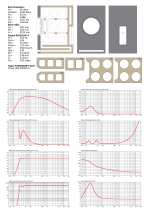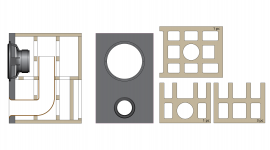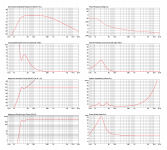Hello friends.
I would like to build a new subwoofer. I designed a subwoofer with the Dayton RSS265HF-4. I calculated a lot of combinations. I would like to share this with you. And I'd like one of you to look at it and comment on the charts. Did I make a mistake somewhere? Could it work well like this? In short, I will list the basic design parameters.
The volume of the box is 50 liters (1.77 cubic feet). The width, height and length of the bass reflex slit are 350 x 25.6 x 929.3 mm (for those using inches it is 13.77 x 1.01 x 36.59 in). Tuning is set to 24 Hz. Box is heavily braced. Construction is made from 22 mm MDF. Front baffle is 44 mm thick.
I will feed it with the Hypex FUSIONAMP FA251 amplifier. It has a power of 250W RMS at 4 Ohm.
In the attachments you will find graphs and a design. You would be very helpful if you looked closely at this experiment. I don't need a new subwoofer, but I really want to. So when I'm going to throw away a lot of money, I want it to play well.
Thanks
I would like to build a new subwoofer. I designed a subwoofer with the Dayton RSS265HF-4. I calculated a lot of combinations. I would like to share this with you. And I'd like one of you to look at it and comment on the charts. Did I make a mistake somewhere? Could it work well like this? In short, I will list the basic design parameters.
The volume of the box is 50 liters (1.77 cubic feet). The width, height and length of the bass reflex slit are 350 x 25.6 x 929.3 mm (for those using inches it is 13.77 x 1.01 x 36.59 in). Tuning is set to 24 Hz. Box is heavily braced. Construction is made from 22 mm MDF. Front baffle is 44 mm thick.
I will feed it with the Hypex FUSIONAMP FA251 amplifier. It has a power of 250W RMS at 4 Ohm.
In the attachments you will find graphs and a design. You would be very helpful if you looked closely at this experiment. I don't need a new subwoofer, but I really want to. So when I'm going to throw away a lot of money, I want it to play well.
Thanks
Attachments
Have you calculated the port velocity? I think it will be ok looking at the port dimensions, doubt it will exceed 35m/s (tenth of speed of sound is typically used as absolute max)
I think the folded port might lead to a slightly lower tuning frequency (effectively extends the port). Also, good practice to compensate for the increase in cross sectional area at the folds, by using triangular pieces for wood for example.
I think the folded port might lead to a slightly lower tuning frequency (effectively extends the port). Also, good practice to compensate for the increase in cross sectional area at the folds, by using triangular pieces for wood for example.
Thank you Mart34.
I'm not sure about that slotted port. I will definitely fill those corners in the tube as you suggest. I also cover the top and back walls with soft felt.
But my dilemma is a little bigger now. I also prepared a design with a classic port. Won't you help me with the decision, please? Is there less risk of going with the slotted port design or a classic PVC pipe? This second design off subwoofer box is in attachment with charts too. Advantage of second design is that in same total volume Vb is little higher. The big disadvantage is that I have no experience with gluing plastic pipes and I am afraid that the joints in the pipe will crack.
Have a nice day.
I'm not sure about that slotted port. I will definitely fill those corners in the tube as you suggest. I also cover the top and back walls with soft felt.
But my dilemma is a little bigger now. I also prepared a design with a classic port. Won't you help me with the decision, please? Is there less risk of going with the slotted port design or a classic PVC pipe? This second design off subwoofer box is in attachment with charts too. Advantage of second design is that in same total volume Vb is little higher. The big disadvantage is that I have no experience with gluing plastic pipes and I am afraid that the joints in the pipe will crack.
Have a nice day.
Attachments
Last edited:
I always wanted a 6" Precision port but couldn't figure out how to bend it. Was tempted to build a mitre specifically to cut it at the required angles. I opted for slot port in the end as it increases rigidity of the enclosure and was easier to build. Not sure what round port size you have there, might be able to find a 90 degree elbow or two 45 elbow, if its 3 or 4 inch.
Hi Mart34.
Fortunately, in our country, a 100 mm plastic oven is a common item. Even with 90 degree elbows. But I'm 99 percent sure I'm going to make a slotted version. Unless no one convinces me with another argument. The speaker and amplifier arrived yesterday. That speaker looks amazing! On the contrary, I was surprised by the amplifier. It is surprisingly light and small. In reviews, however, they rate it very highly. So I'm satisfied. Unfortunately, I have unexpected work around the house. So the construction of the subwoofer will be a bit delayed. At least I can learn how to tune the bass port. I only have a calibrated microphone ready for it. I hope that will be enough. Or should I prepare to purchase additional equipment? How do you measure your speaker boxes?
Thank you.
Fortunately, in our country, a 100 mm plastic oven is a common item. Even with 90 degree elbows. But I'm 99 percent sure I'm going to make a slotted version. Unless no one convinces me with another argument. The speaker and amplifier arrived yesterday. That speaker looks amazing! On the contrary, I was surprised by the amplifier. It is surprisingly light and small. In reviews, however, they rate it very highly. So I'm satisfied. Unfortunately, I have unexpected work around the house. So the construction of the subwoofer will be a bit delayed. At least I can learn how to tune the bass port. I only have a calibrated microphone ready for it. I hope that will be enough. Or should I prepare to purchase additional equipment? How do you measure your speaker boxes?
Thank you.
Hi Mayok, I modelled your slot port design in Winisd, and it corresponds with your design sheet, -7dB at 20Hz, approx 10mm cone excursion and approx 20m/s port velocity.
Regarding measurements, I used a Umik-1 with REW. If your mic is compatible with REW or similar, you'll be able to do everything you need I suspect. What do you mean by tune the port?
Regarding measurements, I used a Umik-1 with REW. If your mic is compatible with REW or similar, you'll be able to do everything you need I suspect. What do you mean by tune the port?
Both the driver and plate amp look like very high quality and well matched components.
Your frequency response looks good. If you wanted some more low end for movies in Home Theater, you could make the box larger. Will be perfect for music, and you'd still get plenty of low end extension with your design anyway, especially compared to even large floorstanders for example.
Your frequency response looks good. If you wanted some more low end for movies in Home Theater, you could make the box larger. Will be perfect for music, and you'd still get plenty of low end extension with your design anyway, especially compared to even large floorstanders for example.
Most people run the port across the bottom and then up the back wall rather than trying to fold it, I think 90 degree corners are something of a “stay away from” if possible, something about slowing the air speed but not increasing length?.?. It could also simplify your build, less cutting. Nice design though.
Thank you gentlemen for your advice.
Audiophile56472, I tried to do it the way you say it. Unfortunately, I have a major problem with the placement of the amplifier. I plan change the port length after measuring the physical prototype. Could this eliminate the difference between a software design and a real product?
Mart34: about that tuning. I designed the bass reflex in software with exact frequency. However, when I physically assemble the Subwoofer, this frequency will probably be a little different. I don't know if I can interpret the data I get from measurements to shorten or lengthen the port. Intuition tells me that I should make the port a little shorter from the beginning. I assume that the fold will have the effect of a longer port. Lengthening or shortening was what I called port tuning.
Audiophile56472, I tried to do it the way you say it. Unfortunately, I have a major problem with the placement of the amplifier. I plan change the port length after measuring the physical prototype. Could this eliminate the difference between a software design and a real product?
Mart34: about that tuning. I designed the bass reflex in software with exact frequency. However, when I physically assemble the Subwoofer, this frequency will probably be a little different. I don't know if I can interpret the data I get from measurements to shorten or lengthen the port. Intuition tells me that I should make the port a little shorter from the beginning. I assume that the fold will have the effect of a longer port. Lengthening or shortening was what I called port tuning.
The tuning frequency will show up in measurements but only to +/- few Hertz at best, and this is only with outdoor free field measurements, since the response in a room would be nothing like what you've modelled due to room modes causing peaks and nulls.
My slot ported design was tuned at 21Hz and my estimate from in room measurements was that it was tuned a couple of Hertz lower. I put this down to my slot port being downward firing, and the space between the bottom of the enclosure and floor became an extension to the port making it slightly longer. But this was with room measurements so it could easily have been the room instead.
My slot ported design was tuned at 21Hz and my estimate from in room measurements was that it was tuned a couple of Hertz lower. I put this down to my slot port being downward firing, and the space between the bottom of the enclosure and floor became an extension to the port making it slightly longer. But this was with room measurements so it could easily have been the room instead.
Measuring a room is actually probably the most important thing. I'm going to listen to music in my living room, not somewhere in the meadow 🙂.
Thank you Mart34. You helped me a lot in deciding and planning this project.
Thank you Mart34. You helped me a lot in deciding and planning this project.
- Home
- Loudspeakers
- Subwoofers
- Subwoofer with Dayton RSS265HF-4


